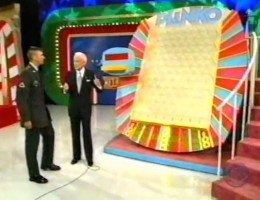Game Theory and ‘The Price is Right’

Many contestants fail to win anything on The Price is Right, of course. But as I watched the venerable game show that morning, it quickly became clear to me that most contestants haven’t thought through the structure of the game they’re so excited to be playing. It didn’t bother me that Margie didn’t know how much a stainless steel oven range costs; that’s a relatively obscure fact. It bothered me, as a budding mathematician, that she failed to use basic game theory to help her advance. If she’d applied a few principles of game theory — the science of decision-making used by economists and generals — she could have planted a big kiss on Bob Barker’s cheek, and maybe have gone home with … a new car! Instead, she went home empty-handed.
At Slate, Ben Blatt explains how winning on The Price is Right is really all about game theory, or strategic decision making. Here’s his example from Contestants Row, the segment on the show where contestants guess the prices of various goods — the person who guesses the closest to the retail price without going over gets to move forward in the show:
In one instance, when Margie was the last contestant to bid, she guessed the retail price of an oven was $1,150. There had already been one bid for $1,200 and another for $1,050. She therefore could only win if the actual price was between $1,150 and $1,200. Since she was the last to bid, she could have guessed $1051, expanding her range by almost $100 (any price from $1051 to $1199 would have made her a winner), with no downside. What she really should have done, however, is bid $1,201. Game theory says that when you are last to bid, you should bid one dollar more than the highest bidder. You obviously won’t win every time, but in the last 1,500 Contestants’ Rows to have aired, had final bidders committed to this strategy, they would have won 54 percent of the time. Instead, last bidders too often rely on their intuition, or on suggestions called out by delirious audience members. As a result, they have won only 35 percent of the time. Contestants in this sample of 1,500 who guessed a value between the highest and second-highest current guesses, as Margie did, win only 20 percent of the time. In this instance, the oven cost $1,999. Margie lost again.
Blatt also has a pretty incredible cheat sheet to all The Price is Right games at the end of his piece. (Unrelated: When I was a kid, I made my own Plinko game by hammering nails into a board and then using checkers pieces as game discs.)
Support The Billfold
The Billfold continues to exist thanks to support from our readers. Help us continue to do our work by making a monthly pledge on Patreon or a one-time-only contribution through PayPal.
Comments